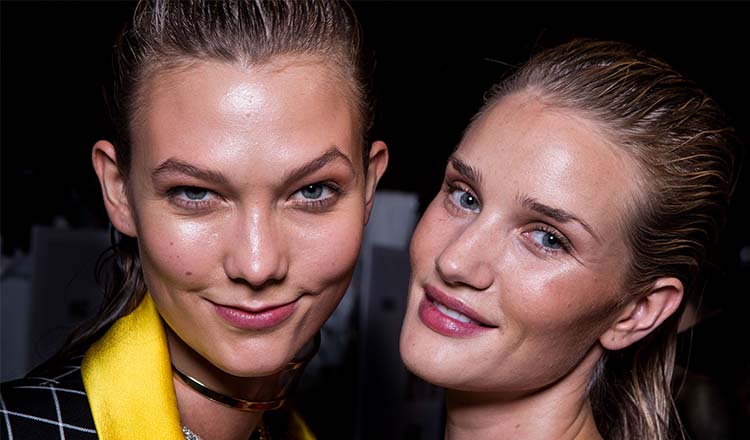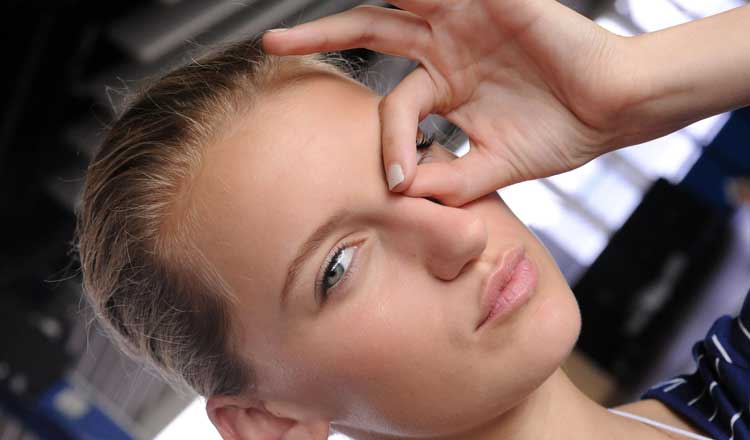I have always had good, if not perfect, skin. I got out of my teens with only a few rounds of Clearasil to speak of and spent my early twenties partying and sleeping in makeup with nary a blemish to speak of. At 24, I made some drastic life changes. I had turned my life-long passion for makeup into a profession and was working in the beauty industry as a freelance artist and salesgirl. I had returned to University to complete my English Literature degree and was pushing myself hard.
Somewhere amongst the onslaught of stress, study, new products, new skills, and new people, my skin called it quits. I developed deep, cystic acne under my cheekbone, with a lighter scattering across my forehead, chin, chest, and back for good measure. It felt like just as I was trying to get my life in order, my body was rebelling from me.
During this time I tried everything there was to try. Every over the counter treatment, from peels and peroxides – if it had “anti-acne” on it I was sold. This, unsurprisingly, made things considerably worse but I felt panicked and strangely, guilty. The trouble with adult-acne is it can make you feel like a child. I was taking charge of every other area of my life, but my skin was on a rampage. And the internet was full of patronising advice about washing my sheets, removing my makeup and drinking enough water. I did all of those things, with only a mounting water bill to show for it. But I persisted because I wanted to be able to tell people that, despite the evidence, I was actually doing everything right.
Eventually, my acne avoidance strategies become obsessive. I refused to wear my hair up, wore hats and thick foundations with more powder foundations over the top for the brief periods I had to interact with the public. I started to avoid leaving the house because I read that pollution in the air could contribute to acne, and, of course, I couldn’t leave the house without makeup even though every blog told me makeup was the culprit.
One of the most common suggestions during this time was that I try changing my diet. As women, I think we have a tendency to blame ourselves, especially when we perceive failures in our bodies. However, ironically, during this period, I had never been healthier. I had stopped working in hospitality and was finally sleeping regular hours. I quit drinking entirely and between work and study spent most of my time exercising, (and googling acne treatments).
After sugar, the most consistent recommendation by helpful strangers was that I cut dairy out of my diet. Like many women, I have a history of disordered eating that only started to settle in my twenties. One of my methods for weight and anxiety management is eating low GI, and eating foods that make me feel full. Dairy happens to be one of them. I eat yogurt in the morning and cheese in my sandwiches. The idea of cutting out a whole food group didn’t seem feasible or safe for me. I tried a few times but without dairy, I felt starving and anxious.
In the end, Roaccutane and going back on a lower dose of the pill worked for me. Whenever people compliment me on my skin I am quick to credit it to Roaccutane, although they always seem a little disappointed that I haven’t recommended a miracle elixir. In my case, medicine was the best medicine. Post-Roacuttane I feel confident about my skin and spend less time thinking about it. However, amongst my friends and acquaintances, it seems like adult acne remains one of the most persistent and frustrating conditions.
This is why when I met Dermatologist Doctor Cara McDonald at an Allergan event, where she spoke passionately about adult acne, acne scarring, and the mental health impact these common issues have on patients, I decided to ask her all the questions I wanted answering back when I was struggling with more advice than I knew what to do with.
View this post on Instagram
So, here you have it: the exhaustive why, whats, and how of adult acne.
Hi Cara, amongst my friends, within the beauty industry, and on beauty forums, I feel that adult acne is a constant and frustrating topic. Is adult acne actually on the rise?
We don’t have enough reliable information or studies to answer this conclusively. Studies have shown that 12-22% of adult women suffer from acne but only about 20% of these seek medical assistance. Despite this, one-third of visits to dermatologists by women over 25 is for acne.
What we do know though, is with the advent of the internet and social media, two things have happened:
1) women are more concerned with the appearance of their skin and how it compares to others, and
2) we can “research” everything ourselves.
Therefore, women have more access to information and treatment options, but there is also more access to non-expert advice. So, acne has become a much more prevalent topic and concern, even if it’s not more prevalent itself!
The connection between food groups, particularly dairy, and adult acne is hotly contested – do you believe there is a link, and are internal factors liked diet and stress as important in the management of adult acne as the media often suggests?
The causes of acne are multifactorial, and they vary somewhat between individuals.
Red, inflamed bumps and pustules we call acne are caused firstly by a blockage of dead skin cells within the pore. These blockages become inflamed and/or infected. So, to get acne, you need to have a tendency to get blocked pores as well as be prone to inflammation in the skin. [Editor’s note: This explains why some people with dreadful skincare regimes and poor health habits have flawless skin – it’s the genetic lottery factor]
There is evidence though that diet and stress can play a role in acne for some sufferers. In particular, there have been a number of studies that have associated acne with low-fat dairy consumption. Although this link has been confirmed, it does not prove causation and the exact mechanism has not yet been determined. It is known that dairy foods may cause irritation in the gut for some people and set off an inflammatory response which could trigger acne. Alternatively, high GI foods (such as sugars and low-fat dairy) are associated with increased insulin and growth factors that can also exacerbate acne. Stress hormones such as cortisol are also known to trigger acne.
Family history (or genetics) and increased sensitivity to hormonal changes are the main underlying factors that result in congestion and inflammation.
Ultimately each person needs to carefully examine possible causes for themselves and work to eliminate their own triggers as much as possible.
Anecdotally, I feel that changes in birth control have been a trigger for many of my friends adult acne horror stories (either going off birth control or changing birth control) – what factor do you think birth control plays in the prevalence of adult acne?
The effect of the oral contraceptive pill on acne is variable and often causes confusion because different pills have different ingredients which have different effects on the skin.
The progesterone component of the combined oral contraceptive pill is considered the most important factor in determining whether an oral contraceptive pill is likely to improve or worsen your acne. Androgens (male hormones) often play a role in the development of acne and some pill ingredients can act to block the effect of androgens in the skin. Cyproterone acetate and drospirenone are the more common ingredients in the pill which block the effects of androgens in the skin. Those that usually help acne tend to be named after female names, eg Estelle, Brenda or Yasmin.
Pills with anti-androgen effects can be particularly useful in treating females with adult acne, especially those experiencing pre-menstrual flares, but the effect may take up to 6 months. Other pills may not help at all, but it is unusual for women to experience a significant worsening of their acne from the oral contraceptive pill alone.
What are your preferred treatments for adult acne sufferers?
We fortunately have many good treatment options for acne, but the most important thing is to first carefully assess the patient, the triggers, the skin type and the type of acne.

I would broadly categorise patients into three groups:
(1) those with mild, localised or superficial acne, where appropriate over-the-counter skincare may be sufficient
(2) those with inflammatory papules and pustules and/or hormonal acne where medicated products and/or anti-androgen treatment is required
(3) those with severe, extensive, deep, cystic or scarring acne.
In this third group, I would strongly suggest an urgent referral to a dermatologist for more aggressive treatment. In most cases, if the patient is appropriate, we would offer prescription vitamin A medication, as this is generally the most effective treatment for severe acne and reduces the chance of scarring and recurrent acne down the track. Patients with acne scarring are highly prone to lowered confidence and long-term self-esteem issues. Treatment for acne scarring is much more difficult and expensive than treatment for acne which can almost always prevent scarring if started early enough.
In more mild cases, where over-the-counter products are appropriate, it is important to find products with a sufficient amount of active ingredients to clear the blocked pores but not so much that they cause excessive irritation or inflammation. It also depends on the underlying skin type and co-existing problems. It’s always wise to consult with an expert dermal therapist or dermatologist to get the right treatment for each particular case. Some ingredients that are helpful are:
- Salicylic Acid – keratolytic (breaks down bonds between dead skin cells to remove blockages in pores and prevent further formation), promotes cell turnover to help repair collagen
- B-lipo hydroxy acid (LHA) – gentle keratolytic action even at low concentrations due to lipophilic properties (attracted to the fatty nature of skin cells), antibacterial and anti-inflammatory.
- Alpha hydroxy acids (AHAs) -eg glycolic acid, citric acid, lactic acid
Potent keratolytic (chemical exfoliants). Increase cell turnover and hyaluronic acid in the skin (increased hydration). It can be quite irritating.
- Zinc – anti-inflammatory and regulates sebum (oil) production
- Niacinamide (vitamin B3) – potent anti-inflammatory action, anti-oxidant (protective against DNA damage) and increases skin hydration. Helps repair skin barrier function.
- Retinols (Vitamin A derivatives) – regulate cell turnover to reduce blockages and increase collagen turnover to help scarring. Can be irritating
One of the most frustrating aspects of adult acne are the scars it leaves behind – what treatments to you recommend for those suffering post-inflammatory pigmentation or “ice pick” scarring?
Acne scarring can be devastating and is associated with lower social functioning and mental health problems for many sufferers. Fortunately, we have many effective treatment options, but they still come at a cost, in terms of pain, downtime, and money. The body has amazing healing properties and in some cases, time alone can see a great improvement in scarring. Basic topical therapy with prescription-strength vitamin A cream can improve collagen regeneration and help scarring to some degree. Strict sun protection and gentle skincare is also important.
Again, the best treatment for any given individual will vary greatly, and is determined by skin type, scar type, extent, severity, pain tolerance and budget. In most cases combination treatments are most effective as we are targeting different depths in the skin with different treatments. A dermatologist who specialises in acne scarring and offers a range of treatment options should be consulted to work out the best approach.
Our most frequently used methods for treating acne scars include:
- Dermal fillers – to lift depressed scars and promote new collagen formation
- Subcision – a process to manually break up deep, tethered scars and induce new collagen
- TCA CROSS – a technique using high concentration trichloroacetic acid to the base of ice-pick scars to repair and lift the base
- Fractional resurfacing laser – creating very finely controlled full thickness damage through the skin layers to stimulate skin repair and promote further collagen production
- Surgical excision of deep difficult scars
So, if you are struggling with adult acne, my advice is do not struggle alone, and do not struggle on the internet! Find a dermatologist and explore your options with them.
Need to know more? Match your acne-fighting ingredient to a top tier product with our roundup of the best skincare purchases you can make by ingredient – from AHA’s to antioxidants.









